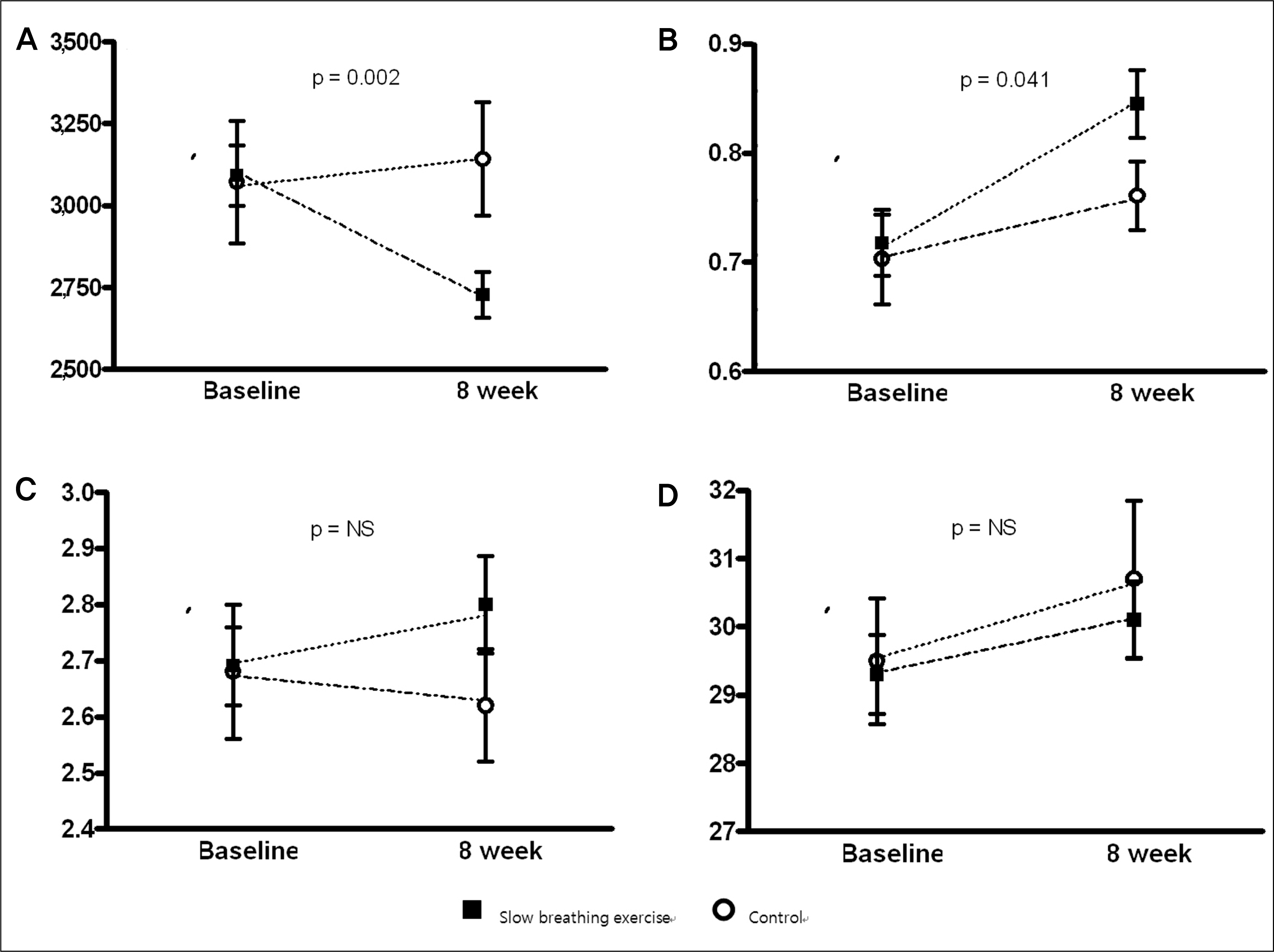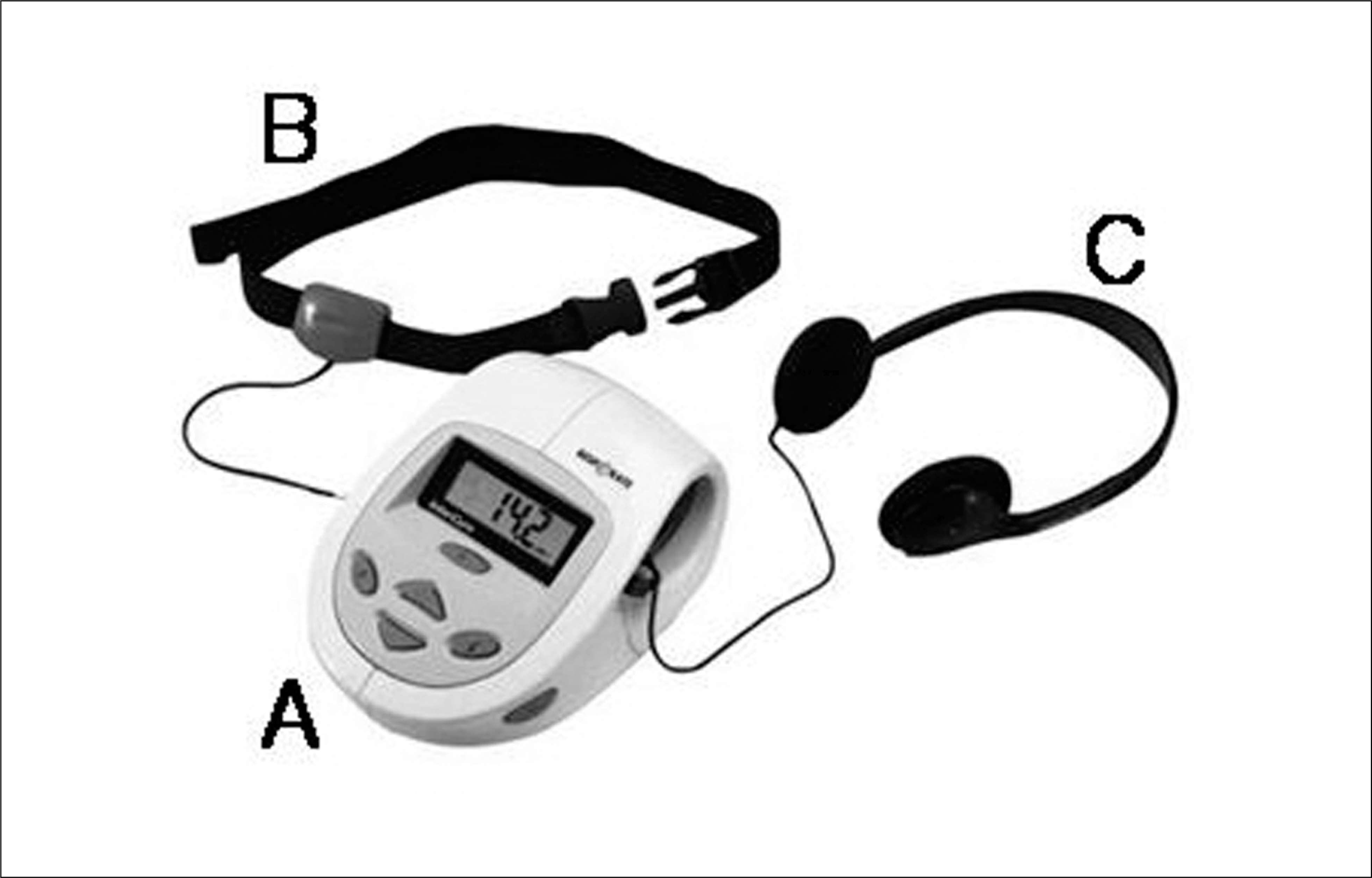ABSTRACT
Background:
The device-guided breathing (DGB) exercise is a non-pharmacological treatment of high blood pressure (BP). Changes in hemodynamic variables after DGB remain to be defined. This study evaluated the hemodynamic effects of DGB in hypertensive patients.
Methods:
Fifty-nine hypertensive individuals (male, 56%; age, 44 ± 10 years) with systolic BP (SBP) in the range of 140 to169 mm Hg and diastolic BP (DBP) < 105 mm Hg were divided into two group: control group (n = 17) vs. DGB group (n = 42) who slowed respiratory rate by using 15 minutes daily DBG (RESPeRATE) over 8 weeks. Heart rate, BP and hemodynamic parameters including cardiac index (CI), thoracic fluid content (TFC), systemic vascular resistance index (SVRI) and total arterial compliance index (TACI) were measured using the ICG Monitor (CardioDynamics) at baseline and study end.
Results:
Baseline characteristics were not different between the two groups. Office BP (SBP/DBP) was reduced from baseline to end value by 13.2 ± 11.1/6.9 ± 7.5 mm Hg in DGB group and 2.2 ± 6.9 /0.5 ± 6.6 mm Hg in control group (p = 0.001, p = 0.004, respectively). Heart rate, CI, stroke index, and TFC were not changed in both groups. However, the SVRI was lower and the TACI was higher in DGB group than control group (SVRI: 2,728 ± 599 vs. 3,141 ± 714 dyne sec m2/cm5, p = 0.002; TACI: 0.845 ± 0.194 vs. 0.761 ± 0.184 mm Hg/mL/m2, p = 0.041).
References
1. Wang TJ, Vasan RS. Epidemiology of uncontrolled hypertension in the United States. Circulation. 2005; 112:1651–62.

2. Chobanian AV, Bakris GL, Black HR, Cushman WC, Green LA, Izzo JL Jr, et al. The Seventh Report of the Joint National Committee on Prevention, Detection, Evaluation, and Treatment of High Blood Pressure: the JNC 7 report. JAMA. 2003; 289:2560–72.

3. Schein MH, Gavish B, Herz M, Rosner-Kahana D, Naveh P, Knishkowy B, et al. Treating hypertension with a device that slows and regularises breathing: a randomised, double-blind controlled study. J Hum Hypertens. 2001; 15:271–8.

4. Grossman E, Grossman A, Schein MH, Zimlichman R, Gavish B. Breathing-control lowers blood pressure. J Hum Hypertens. 2001; 15:263–9.

5. Meles E, Giannattasio C, Failla M, Gentile G, Capra A, Mancia G. Nonpharmacologic treatment of hypertension by respiratory exercise in the home setting. Am J Hypertens. 2004; 17:370–4.

6. Rosenthal T, Alter A, Peleg E, Gavish B. Device-guided breathing exercises reduce blood pressure: ambulatory and home measurements. Am J Hypertens. 2001; 14:74–6.

7. Mahtani KR, Nunan D, Heneghan CJ. Device-guided breathing exercises in the control of human blood pressure: systematic review and meta-analysis. J Hypertens. 2012; 30:852–60.
8. Bae JH, Kim JH, Choe KH, Hong SP, Ko JK, Kim CH, et al. Effect of device-guided breathing exercise on blood pressure control: Korean Multi-center Study. Korean Hypertension J. 2006; 12:19–23.
9. Cooke WH, Cox JF, Diedrich AM, Taylor JA, Beightol LA, Ames JE 4th, et al. Controlled breathing protocols probe human autonomic cardiovascular rhythms. Am J Physiol. 1998; 274(2 Pt 2):H709–18.
10. Yancy C, Abraham WT. Noninvasive hemodynamic monitoring in heart failure: utilization of impedance cardiography. Congest Heart Fail. 2003; 9:241–50.

Fig. 1.
The changes of the key hemodynamic variables between baseline and study end. Values are presented as mean ± standard errors. (A) Systemic vascular resistance index. (B) Total arterial compliance index. (C) Cardiac index. (D) Total fluid contents. NS, non-significant.

Fig. 2.
Components of RESPeRATE (InterCure). (A) Computerized control unit. (B) Respiratory muscle activity monitor (sensor belt). (C) Headphone.

Table 1.
Baseline characteristics of study subjects
Table 2.
Hemodynamic variables between baseline and study end
| Variable | Baseline | End | Changes |
|---|---|---|---|
| Control (n = 17) | |||
| Systolic BP (mm Hg) | 148.1 ± 7.6 | 146.0 ± 8.5 | 2.2 ± 6.9 |
| Diastolic BP (mm Hg) | 94.2 ± 6.9 | 93.7 ± 6.6 | 0.5 ± 6.7 |
| Heart rate (rate/min) | 72.5 ± 11.7 | 72.7 ± 9.5 | -0.2 ± 6.0 |
| Cardiac index (L/min/m2) | 2.68 ± 0.49 | 2.62 ± 0.42 | - |
| SVRI (dyne sec m2/cm5) | 3072 ± 772 | 3141 ± 714 | - |
| Velocity index | 45.9 ± 19.7 | 44.8 ± 14.5 | - |
| Total fluid content (/kOhm) | 29.5 ± 3.8 | 30.7 ± 4.8 | - |
| TACI (mm Hg/mL/m2) | 0.703 ± 0.169 | 0.761 ± 0.184 | - |
| Slow breathing exercise (n = 42) | |||
| Systolic BP | 152.8 ± 9.1 | 139.6 ± 10.7* | 13.2 ± 11.1† |
| Diastolic BP | 95.8 ± 6.9 | 89.0 ± 6.9* | 6.9 ± 7.5† |
| Heart rate (rate/min) | 70.0 ± 7.1 | 71.2 ± 9.5 | -0.2 ± 11.3 |
| Cardiac index (L/min/m2) | 2.69 ± 0.47 | 2.80 ± 0.56 | - |
| SVRI (dyne sec m2/cm5) | 3092 ± 599 | 2728 ± 599† | - |
| Velocity index | 46.9 ± 13.4 | 51.8 ± 13.4 | - |
| Total fluid content (/kOhm) | 29.3 ± 3.8 | 30.1 ± 3.7 | - |
| TACI (mm Hg/mL/m2) | 0.718 ± 0.182 | 0.845 ± 0.194* | - |




 PDF
PDF ePub
ePub Citation
Citation Print
Print


 XML Download
XML Download